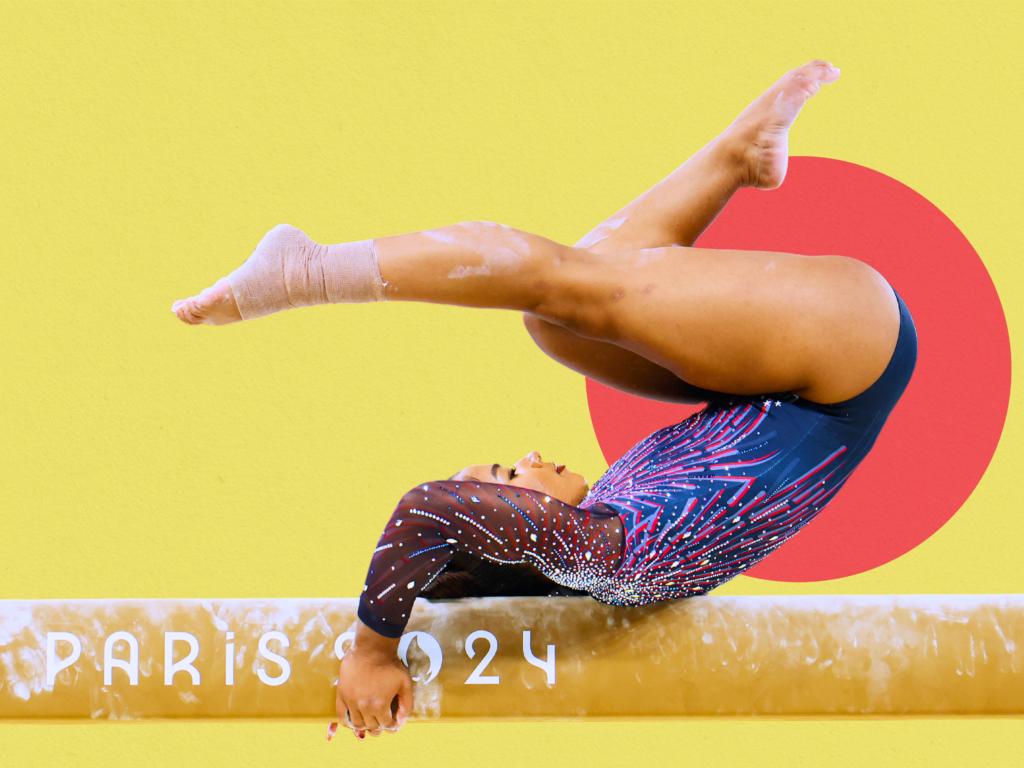It’s undeniably impressive that Olympic gymnasts compete without so much as losing a false eyelash or misplacing a hair in a sleek bun—but have you ever wondered how they sprint, leap, and flip while avoiding major wedgies? As it turns out, the semi-permanence of their signature leotards is no accident. A very intentional, custom design ensures the fabric doesn’t slip or slide.
This comes down to two main factors: the fit and the material, according to Jeanne Diaz, the Director of Design at GK Elite, the exclusive provider of American gymnasts’ on-mat attire for the Olympic Games. “A proper-fitting leotard is the most effective way to avoid back-side discomfort while competing,” Diaz tells SELF. “GK has spent decades developing and innovating proprietary designs, patterns, and specialty fabrics to ensure a perfect fit and performance for our athletes.”
She adds that “GK uses a wide variety of fabrics across all the Olympic designs,” but often relies on nylon or polyester-spandex as a base. Select leos might also be dressed up with mesh, jacquard mesh (which has a specialized, circular weave known for its breathability), and/or stretch satin. “Some of the fabrics have a metallic foil on top of the nylon/spandex base,” Diaz says, which gives off that classic shine.
And those dazzling outfits aren’t created overnight—the design process actually begins about two years ahead of the Olympics. Each leotard is tailored to a gymnast’s specific measurements, and to accommodate potential body changes, GK Elite “measures and fits all national team athletes annually,” followed by any necessary alterations, Diaz says.
After the design is set, the leos are cut and assembled at Elite Sportswear headquarters in Reading, Pennsylvania. (And the Games don’t mark the players’ first try-on. Trial wears and testing are a crucial step in getting the garments just right.) When the Olympics finally come around, Diaz says that GK Elite also sends Team USA a few spare leos, “just in case.”
Body adhesives (affectionately referred to as “butt glue” by gymnasts) and special underwear are also options for anti-wedgie reinforcement, but are “not a substitute for a well-fitted leotard,” Diaz says. A lot of gymnasts aren’t about taking chances, though, because picking a wedgie isn’t just uncomfortable—fiddling with the fabric mid-routine could potentially hurt their final score. That’s why some athletes go the extra mile and literally adhere the material to their skin.
“A lot of people use, like, sticky spray for your butt so your leotard doesn’t move,” gymnast Nastia Liukin, 2008 all-around Olympic gold medalist, told People in 2016. She was referring to a product like Tuf-Skin, and called it out for another perk too: “We use it for our wrists before we put tape on underneath our grips, because we’re sweaty and it [gives] a little extra stick.”
All of this probably has you wondering what the designs look like for this year’s Olympics. For the first time, Team USA’s leotards were unveiled before the Games—and they feature thousands of Swarovski crystals, as well as pearls (“a tribute to the host city of Paris”). GK offers replicas to match your favorite gymnasts, but they obviously don’t get the same custom treatment as the official ’fits. So if you pick one up, just beware that they might not be as wedgie-proof.
SELF is your one-click source for all things Summer Olympics. Read our latest coverage of the Paris Games here.
Related:
Meet Team USA’s 2024 Olympic Gymnastics TeamEverything Suni Lee Has Shared About Her Rare Kidney DiseaseHere’s What Team USA Athletes Will Be Eating at the Paris Games
>>> Read full article>>>
Copyright for syndicated content belongs to the linked Source : Self.com – https://www.self.com/story/how-do-gymnasts-avoid-wedgies
